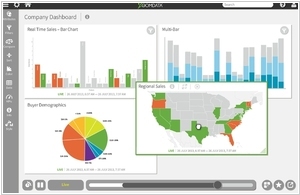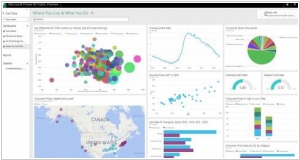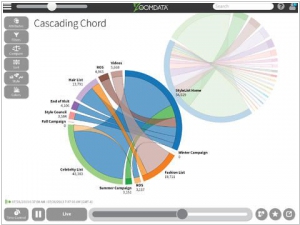Microsoft Power BI vs Zoomdata
June 10, 2023 | Author: Michael Stromann
Microsoft Power BI and Zoomdata are both data visualization and analytics platforms, but they differ in their features, capabilities, and target users.
Microsoft Power BI is a comprehensive business intelligence tool that enables users to connect, analyze, and visualize their data. It offers a wide range of data connectors, advanced analytics capabilities, and interactive visualizations. Power BI allows users to create customizable dashboards, reports, and data models. It also provides collaboration features, integration with other Microsoft products, and robust sharing and publishing options. Power BI is suitable for organizations of all sizes and industries, with a focus on self-service analytics and enterprise-grade data management.
Zoomdata, on the other hand, is a data visualization platform designed to provide real-time analytics and exploration of big data. It specializes in handling large datasets, streaming data, and complex data sources. Zoomdata offers interactive visualizations, data drilling capabilities, and real-time data connectivity. It focuses on delivering fast and dynamic data insights to users, especially for real-time and time-sensitive analytics scenarios. Zoomdata is often used in industries such as finance, telecommunications, and e-commerce, where real-time data analysis is critical.
See also: Top 10 Business Intelligence software
Microsoft Power BI is a comprehensive business intelligence tool that enables users to connect, analyze, and visualize their data. It offers a wide range of data connectors, advanced analytics capabilities, and interactive visualizations. Power BI allows users to create customizable dashboards, reports, and data models. It also provides collaboration features, integration with other Microsoft products, and robust sharing and publishing options. Power BI is suitable for organizations of all sizes and industries, with a focus on self-service analytics and enterprise-grade data management.
Zoomdata, on the other hand, is a data visualization platform designed to provide real-time analytics and exploration of big data. It specializes in handling large datasets, streaming data, and complex data sources. Zoomdata offers interactive visualizations, data drilling capabilities, and real-time data connectivity. It focuses on delivering fast and dynamic data insights to users, especially for real-time and time-sensitive analytics scenarios. Zoomdata is often used in industries such as finance, telecommunications, and e-commerce, where real-time data analysis is critical.
See also: Top 10 Business Intelligence software
Microsoft Power BI vs Zoomdata in our news:
2015. Microsoft integrates Cortana into Power BI service

Microsoft has made an announcement stating that the Cortana personal assistant will be integrated into Power BI, its business intelligence tool. It's important to note that Power BI already possessed some natural language query capabilities. With this integration, Cortana will be able to respond to written and spoken queries using data sets from Power BI. For instance, users can ask questions like "What was the revenue for the last quarter?" or request a chart showing the "number of opportunities by team." To utilize this new feature, users must grant Cortana access to their Power BI data sets. It's worth mentioning that Microsoft also offers Cortana Analytics, which caters to enterprises and focuses more on the machine learning and automation services that drive Cortana, rather than the Cortana client itself.
2014. Zoomdata wants to disrupt Business Intelligence market

The highly competitive Business Intelligence (BI) market has seen a disruptor emerge with Zoomdata securing $17 million in Series B funding to drive its mission forward. In contrast to BI competitors like Tableau and Qlik, which originated from the realm of SQL and data warehouses, Zoomdata takes a more contemporary approach to modern data analytics. Built specifically to handle today's platforms such as Hadoop, Spark, and NoSQL, Zoomdata sets itself apart by being designed from the ground up with these technologies in mind. One standout feature of Zoomdata is its ability to stream data in a manner akin to video playback, enabling users to navigate back and forth in time, much like scrubbing a video. This unique capability proves invaluable when working with data, as it allows users to observe the transformation of graphs and visualizations over time, providing crucial insights into evolving trends and patterns. With its innovative approach and powerful features, Zoomdata aims to reshape the BI landscape and deliver cutting-edge analytics solutions.




